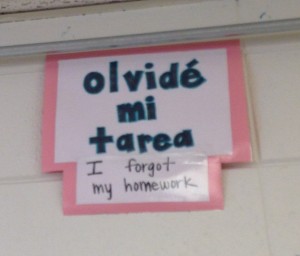(A post for newbies, especially, which should be of interest to others.)
I am sitting in a bright, cheerful Spanish classroom. The teacher here does a whole lot of evening and week-end work. I’ve never met her but I only have to look at this schedule. She is teaching Spanish I, Spanish 2, as well as two different social studies classes, and math for English language learners.
I have been there. Getting ready for five separate subjects takes an enormous amount of time, at least for a teacher determined to do right by her students. You can borrow from colleagues and the internet but, in the end, each day’s instruction should follow from the previous day’s instruction; frequently the only way can happen will require creating original materials and activities.
This room has activities and posters all over the wall. The Spanish/ELL teacher here must love decorating, she does it so well. I particularly like the clock. When I first entered the room, I was impressed with the learning possibilities on the walls. We have the alphabet, numbers, colors, shapes, days of the week, months of the year, various body parts, types of animals, common verbs, greetings and, up on top of the whiteboard, a set of useful Spanish phrases, helping students to tell their teacher in Spanish that they need to go to the bathroom or forgot their homework, among other common daily phrases.
After I had enjoyed looking around the room, I struck by an absence, though, and I’d like to blog that missing piece. Where are the standards? I know they exist. She has a slot for them on the wall. I am sure she provides those standards. But they occupy a small space on her wall. I was pleased to see that almost all the material in this room is for learning — rather than for learning about learning.
This post is for newbies. Maybe you are being told to put all your standards and plans up so that students can read them and know your master plan. Supposedly, this helps students. I’d like to observe that until recently few people — none that I’d ever met — put all this information on the board, but some study indicated that posting standards and plans contributed to classroom learning. Maybe it’s true, maybe it’s not. As I always note, social science studies are often conducted in fairly idyllic conditions which don’t translate well in all classrooms.
But since keeping students abreast of the standards and lesson plan has become all the rage, I will go with this flow. I’d like to observe, though, that all minutes we use in a classroom are taken away from other activities and instruction we might have provided, had we made alternative instructional choices instead. Those missing fragments in our lessons are our opportunity costs. When we spend too much time telling students what we plan to do, we take away from actual doing.
As Yoda said, “Do or do not do. There is no try.” Spending too much time explaining a standard or the flow of a projected lesson strikes me as a version of trying. While our students are learning the content of Common Core standards, they are not actually learning the math the standard requires.
By all means, if administration requires that you post your standards and lesson plan for each day for students to see, do so. Some battles aren’t worth fighting and maybe the standards will help students. (We got along for decades without them, of course, and today’s students don’t seem to be overtaking students of the past, even with the new standards plastered all over the place.) But be alert to the time loss the class incurs from talking about those standards and plans. The time we spend telling students that they are going to learn how to calculate ratios could actually be spent teaching students how to calculate ratios.


